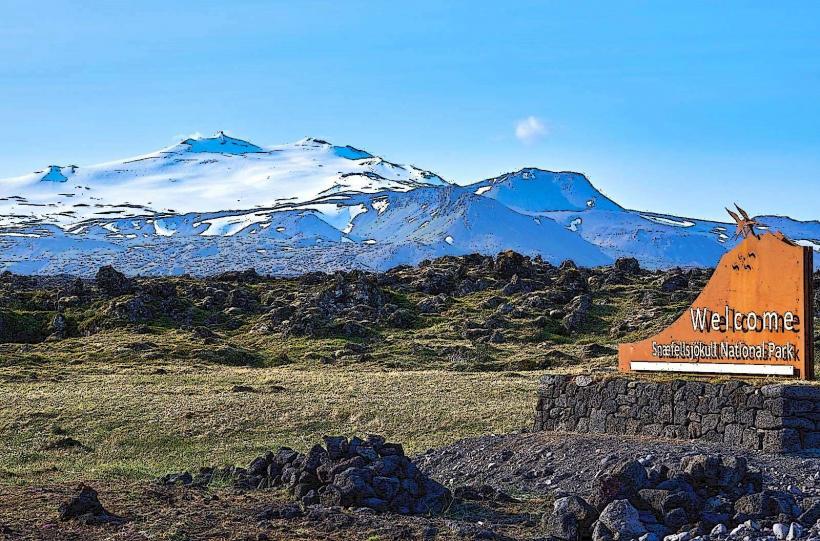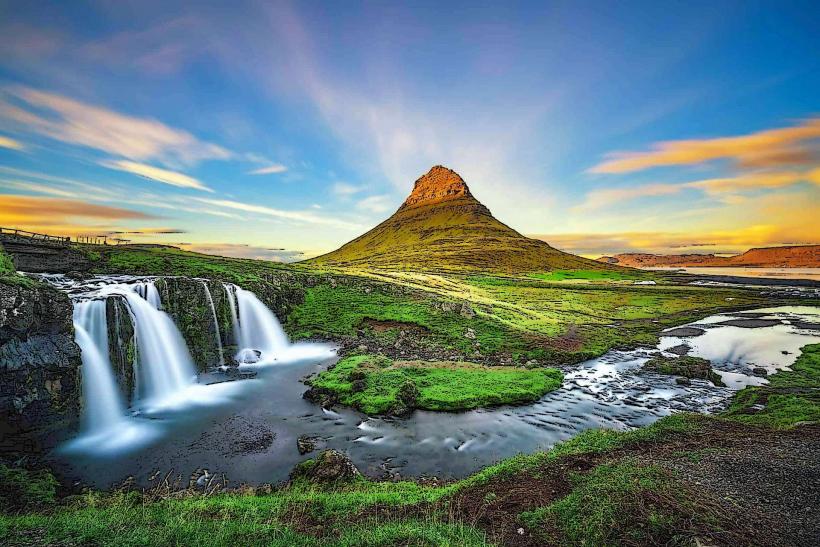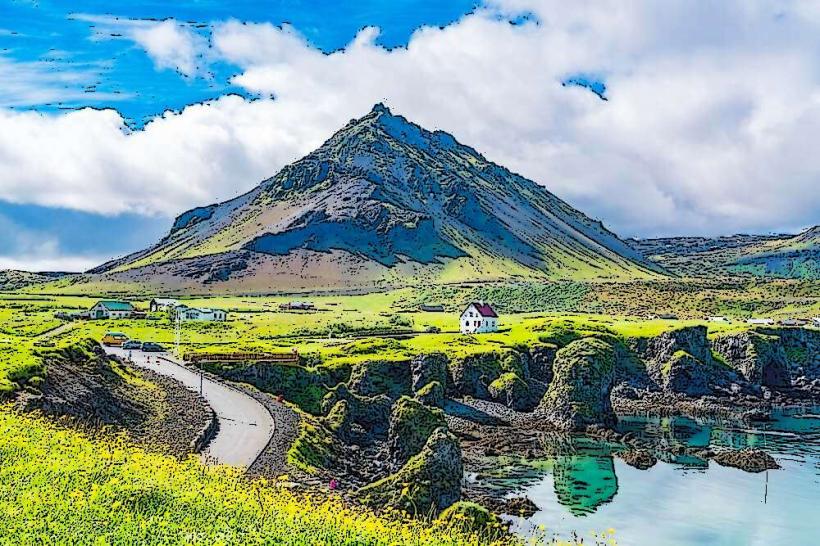Information
Landmark: Lóndrangar CliffsCity: Snaefellsnes
Country: Iceland
Continent: Europe
Lóndrangar Cliffs are one of the most iconic natural landmarks on the Snæfellsnes Peninsula in West Iceland, located within the boundaries of Snæfellsjökull National Park. These towering basalt rock formations stand proudly along the coast, offering breathtaking views and a unique glimpse into the volcanic geology that defines much of Iceland's landscape.
Overview
- Location: Lóndrangar is situated along the southern coast of the Snæfellsnes Peninsula, approximately 5 kilometers (3.1 miles) west of the village of Arnarstapi and 11 kilometers (6.8 miles) east of Hellnar. The cliffs rise dramatically from the sea, making them easily visible from various points along the coast.
- Geological Composition: Lóndrangar is a pair of basalt pinnacles that were formed from volcanic activity millions of years ago. These formations are the remnants of a volcanic crater that has eroded over time, leaving behind these striking spires that stand out against the landscape. The larger of the two pinnacles is called "The Church" (because of its resemblance to a steeple), and the smaller one is known as "The Needle."
Geological Significance
- Formation: Lóndrangar was once part of a larger volcanic crater that has eroded over time. The basalt rocks were originally formed from lava flows during the volcanic activity that occurred on the Snæfellsnes Peninsula millions of years ago. Over time, the softer materials around the rocks eroded, leaving the more resistant basalt pinnacles exposed.
- Erosion and Preservation: The natural process of erosion over thousands of years has shaped the cliffs into their current forms, making them a prime example of Iceland's volcanic landscape. The rocks are believed to be between 4 and 5 million years old, which adds to their geological importance.
Wildlife and Birdwatching
Lóndrangar is a prime spot for birdwatching, especially during the summer months when seabirds nest along the cliffs. The area is home to various species of birds, including:
- Puffins: Puffins are one of the most popular birds in Iceland and can often be seen nesting along the cliffs of Lóndrangar during the breeding season (May to August). The cliffs offer an ideal environment for puffins to build their nests in the rocky outcrops.
- Gulls and Kittiwakes: These seabirds are also commonly found in the area, nesting in the cliff faces and flying overhead.
- Other Seabirds: Various other seabird species such as guillemots and fulmars are also seen nesting and flying around the cliffs.
Lóndrangar Hiking Trail
- Accessing the Cliffs: Lóndrangar is easily accessible by foot and can be reached via a short hiking trail that leads from the parking area located along Route 574. The walk is relatively easy, taking about 15-20 minutes to reach the base of the cliffs from the parking lot. The trail also offers spectacular views of the surrounding coastline, the ocean, and the Snæfellsjökull Glacier in the distance.
- Scenic Views: Along the trail, visitors are treated to panoramic views of the cliffs, the sea, and the rugged coastline. The towering basalt spires of Lóndrangar stand out as a striking contrast against the blue waters of the Atlantic Ocean.
Photographic Opportunities
Lóndrangar is one of the most photographed locations in Iceland, especially due to its dramatic appearance and the surrounding landscape. The stark contrast between the black basalt rocks, the ocean, and the often snow-capped Snæfellsjökull Glacier in the distance makes for an unforgettable photo opportunity. The cliffs are particularly striking during sunrise and sunset when the light creates dramatic shadows and highlights on the rocks.
- Tips for Photographers: For the best shots, consider photographing the cliffs from different angles. The view from a nearby hilltop provides a great vantage point for capturing the entirety of the Lóndrangar formations against the backdrop of the ocean. During the winter months, the cliffs are often dusted with snow, adding another layer of beauty to the scene.
Lóndrangar’s Cultural Significance
In addition to its geological and natural significance, Lóndrangar holds cultural importance in Icelandic folklore. The formations are steeped in myths and legends, particularly those of Viking origin. According to one such legend, the cliffs are the remains of a troll that turned to stone when exposed to sunlight. This type of folklore is common throughout Iceland, where many unusual rock formations are linked to mythical creatures or supernatural stories.
Nearby Attractions
Lóndrangar is located in the heart of Snæfellsjökull National Park, which is home to many other incredible natural wonders, including:
- Snæfellsjökull Glacier: The glacier itself is an active volcano that is famously featured in Jules Verne’s novel Journey to the Center of the Earth. The glacier and its surrounding areas offer opportunities for glacier hiking, exploring lava tubes, and scenic drives.
- Djúpalónssandur Beach: Just a short drive to the west, this black sand beach is home to dramatic rock formations, shipwreck remnants, and historical significance.
- Arnarstapi and Hellnar: These two nearby fishing villages offer stunning coastal views, hiking opportunities, and additional birdwatching spots.
Visitor Facilities
- Parking: There is a designated parking area near the trailhead for Lóndrangar, which is well-marked along Route 574. Visitors can easily park their vehicles and begin the short hike to the cliffs.
- Visitor Information: Information about the area can be found at the Snæfellsjökull National Park Visitor Center in Hellnar. Here, visitors can learn about the park’s natural history, hiking routes, and wildlife.
- Nearby Amenities: The closest towns, Arnarstapi and Hellnar, offer a variety of amenities, including guesthouses, cafes, and small shops, where visitors can relax and enjoy traditional Icelandic food after exploring the cliffs.
Best Time to Visit
- Summer (June to August): This is the best time to visit Lóndrangar, as the weather is milder and the hiking trails are accessible. It is also the prime birdwatching season when puffins and other seabirds are nesting.
- Winter (November to March): While winter brings harsher conditions, it also offers the chance to see the cliffs dusted with snow and potentially catch the Northern Lights in the area. However, winter visits may require more careful planning due to snow and ice.
Conclusion
Lóndrangar Cliffs are a striking natural feature of the Snæfellsnes Peninsula, combining geological wonder with rich wildlife and folklore. The cliffs' dramatic presence, combined with the surrounding scenery of the ocean, lava fields, and the Snæfellsjökull Glacier, make Lóndrangar a must-see destination for nature lovers, photographers, and anyone visiting Snæfellsjökull National Park. The cliffs are not only a geological wonder but also a spot for reflection on Iceland's natural beauty and the legends that tie the land to its rich cultural history.





